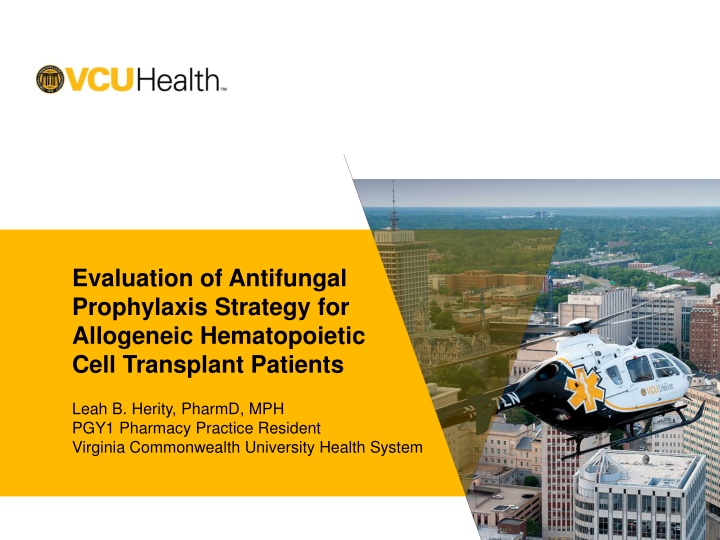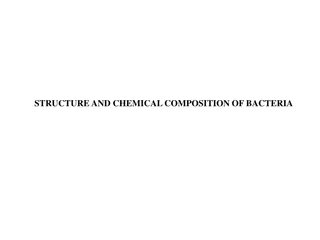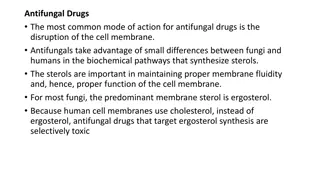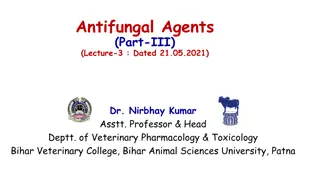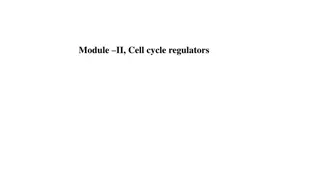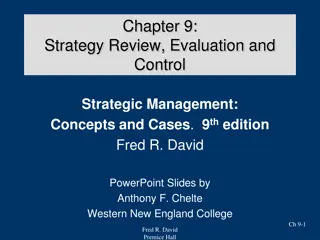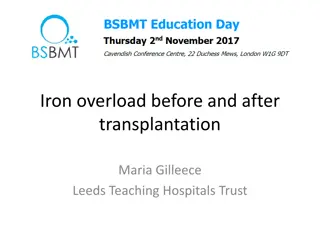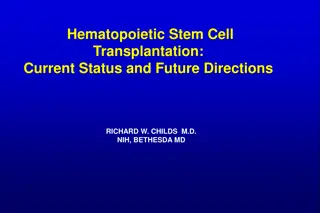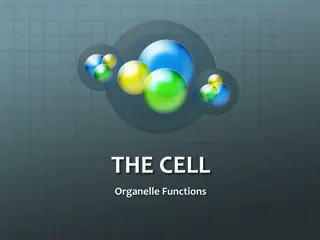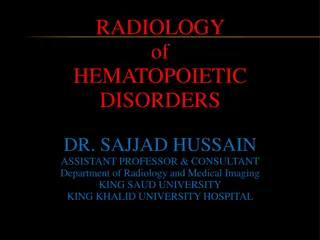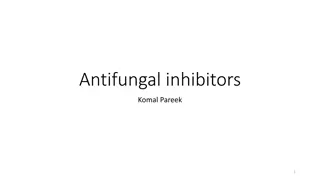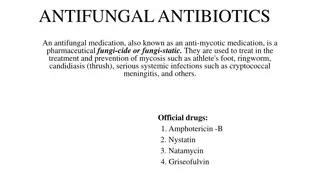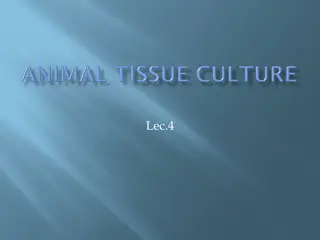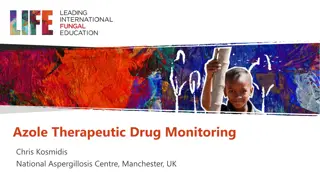Evaluation of Antifungal Prophylaxis Strategy for Allogeneic Hematopoietic Cell Transplant Patients
Antifungal prophylaxis plays a crucial role in preventing invasive mold infections in allogeneic hematopoietic cell transplant patients. This study evaluates the primary antifungal prophylaxis strategy at Virginia Commonwealth University Health System and aims to determine the incidence and outcomes of invasive mold infections in these patients.
Download Presentation

Please find below an Image/Link to download the presentation.
The content on the website is provided AS IS for your information and personal use only. It may not be sold, licensed, or shared on other websites without obtaining consent from the author.If you encounter any issues during the download, it is possible that the publisher has removed the file from their server.
You are allowed to download the files provided on this website for personal or commercial use, subject to the condition that they are used lawfully. All files are the property of their respective owners.
The content on the website is provided AS IS for your information and personal use only. It may not be sold, licensed, or shared on other websites without obtaining consent from the author.
E N D
Presentation Transcript
Evaluation of Antifungal Prophylaxis Strategy for Allogeneic Hematopoietic Cell Transplant Patients Leah B. Herity, PharmD, MPH PGY1 Pharmacy Practice Resident Virginia Commonwealth University Health System
Disclosure The authors and contributors of this project have no conflict of interest to disclose. 2
Invasive Mold Infections (IMI) in Allogeneic Hematopoietic Cell Transplant (HCT) Patients Incidence Ranges from 1.6% to over 10% Risk factors Mismatched or unrelated donor Graft versus host disease (GVHD) Prolonged neutropenia Mortality 1-year survival of 25% Clin Chest Med. 2017 Dec;38(4):727-73 Transpl Infect Dis. 2018;e12897 Biol Blood Marrow Transplant. 2013;19(8):11906 3
Classification of IMI Proven Microscopic analysis Positive culture of sterile material Host factor Clinical criterion Mycological criterion Probable Possible Host factor Clinical criterion Clin Infect Dis. 2008;46(12):1813-21 4
Previous Studies of Antifungal Prophylaxis Study Patients Antifungal Prophylaxis Incidence of Proven or Probable IMI Rosillo et al. (2018) Retrospective review (n = 988) Allogeneic HCT Micafungin 150 mg IV (day +1 to +7) followed by IV/PO voriconazole (day +8 to +100) 1-year incidence: 1.6% 1-year survival after IMI: 25% Wingard et al. (2010) RCT (n = 600) Allogeneic HCT Voriconazole 200 mg PO BID vs. fluconazole 400 mg PO daily (day 0 to +100) Voriconazole: 7.9% Fluconazole: 8.8% Ullmann et al. (2007) RCT (n = 600) Allogeneic HCT with GVHD Posaconazole suspension 200 mg TID vs. fluconazole 400 mg once daily (GVHD through 112 days) Posaconazole: 2.3% Fluconazole: 7.0% RCT = randomized, controlled trial Transpl Infect Dis. 2018;e12897 Blood. 2010;116(24):5111-8 N Engl J Med. 2007;356(4):335-47 5
Primary Antifungal Prophylaxis Strategy at Virginia Commonwealth University (VCU) Health System Pre-engraftment Post-engraftment Micafungin 50 mg IV daily Day 1 through engraftment (~day 10-14) Fluconazole 400 mg PO daily Duration of immune suppression Patients may be switched to other antifungals depending on certain characteristics 6
Objective To determine the incidence and outcomes of IMI in allogeneic HCT patients at VCU Health System receiving primary antifungal prophylaxis 7
Methods Retrospective medical record review o Data collected from Cerner Information Systems o January 1, 2013 through December 31, 2017 o Patients followed for 1 year post-transplant Quality improvement project o VCU Institutional Review Board o Massey Cancer Center Protocol Review and Monitoring Committee (PRMC) 8
Study Population Inclusion Criteria Exclusion Criteria Allogeneic HCT patients age > 18 years old Initially treated with micafungin for primary antifungal prophylaxis after transplant Prisoners Pregnancy 9
Endpoints Primary Incidence rate of proven or probable IMI Secondary Median time to proven or probable IMI IMI-related mortality* Proven or probable IMI characteristics Risk factors associated with IMI *Death within 12 weeks of IMI diagnosis 10
Statistical Analysis Demographics o Descriptive statistics Primary outcome o Incidence rates o Kaplan-Meier survival estimates and log-rank tests Secondary outcomes o Descriptive statistics o Chi-squared and Fisher s Exact tests for risk factors Analyses performed in Stata MP 15.1 11
Patient Characteristics Characteristic IMI Patients (n = 48) 54.5 (19-70) Non-IMI Patients (n = 152) 55 (20-73) Age, median (range) Male sex, n (%) 30 (62.5) 85 (55.9) Weight in kg, mean (SD) 88.7 (21) 85.1 (19.6) Underlying disease, n (%) Acute myeloid leukemia 13 (27.1) 43 (28.3) Myelodysplastic syndrome 9 (18.8) 22 (14.5) Acute lymphoblastic leukemia 3 (6.3) 20 (13.2) Lymphoma 8 (16.7) 15 (9.9) Myelofibrosis 3 (6.3) 17 (11.2) Other 12 (25) 35 (23) No statistically significant differences between groups 12
Patient Characteristics Characteristic IMI Patients (n = 48) Non-IMI Patients (n = 152) Transplant type, n (%) Matched related 9 (18.8) 57 (37.5) Matched unrelated 28 (58.3) 63 (41.5) Umbilical cord blood 6 (12.5) 16 (10.5) Other 5 (10.4) 16 (10.5) Conditioning intensity, n (%) Myeloablative 36 (75) 108 (71) Reduced intensity 12 (25) 44 (29) Post-transplant complications, n (%) Acute GVHD 31 (64.6) 89 (58.6) Chronic GVHD 12 (25) 51 (33.6) Death* 31 (64.6) 37 (24.3) *P<0.001 by chi-squared test 13
Proven or Probable IMI Outcome All Patients (n = 200) 48 (24) Incidence Rate Proven or probable IMI, n (%) 33 cases per 100 patient-years IMI-related mortality, n (%) 27 (13.5) Time to IMI diagnosis, median days from transplant (IQR) 94 (23-178) 14
Proven or Probable IMI Characteristics Outcome, n (%) IMI Patients (n = 48) Proven IMI 6 (12.5) Probable IMI 42 (87.5) Antifungal at IMI diagnosis Micafungin 14 (29.2) Fluconazole 17 (35.4) Voriconazole 16 (33.3) Posaconazole 1 (2.1) Steroid use in prior 30 days 27 (56.3) Curvularia (1) Rhizopus (2) Rhizomucor (1) Other (3) Fusarium (3) Aspergillus (3) Zygomycetes (1) Positive -D-Glucan 27 (56.3) Positive Galactomannan 23 (47.9) Positive culture 14 (29.2) 15
Proven or Probable IMI by Underlying Disease P-value = 0.44 ALL = acute lymphoblastic leukemia | AML = acute myeloid leukemia MDS = myelodysplastic syndrome 16
Proven or Probable IMI by Transplant Type P-value = 0.09 MRD = matched related donor | MUD = matched unrelated donor 17
Overall Survival P-value < 0.0001 18
Limitations Retrospective design Single-center study No comparator group for the primary outcome Inconsistent documentation in the medical record 19
Conclusions The incidence of proven or probable IMI was higher than expected IMI was diagnosed most frequently during the first 100 days post-transplant No risk factors for IMI diagnosis were identified IMI diagnosis was associated with significantly reduced overall survival Conclusions The primary antifungal prophylaxis strategy for allogeneic HCT patients at VCU Health System will be reassessed Present results to the Bone Marrow Transplant, Transplant Infectious Diseases, and Antimicrobial Stewardship groups at VCU Health System Impact & Future Steps 20
Acknowledgments May T. Aziz, PharmD, BCPS, BCOP Teresa Potter, PharmD, MPH, BCPS Oveimar A. De la Cruz, M.D. 21
Questions? Leah B. Herity, PharmD, MPH leah.herity@vcuhealth.org 804-828-6748 22
